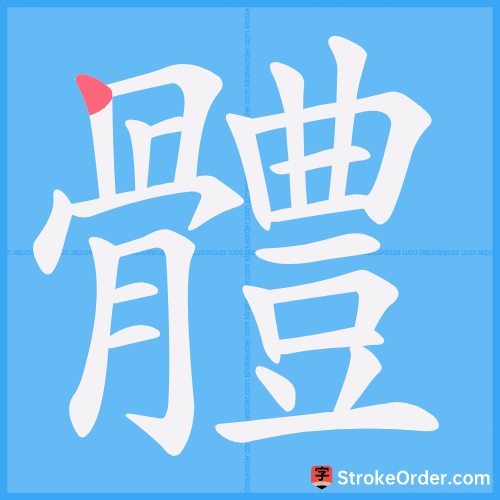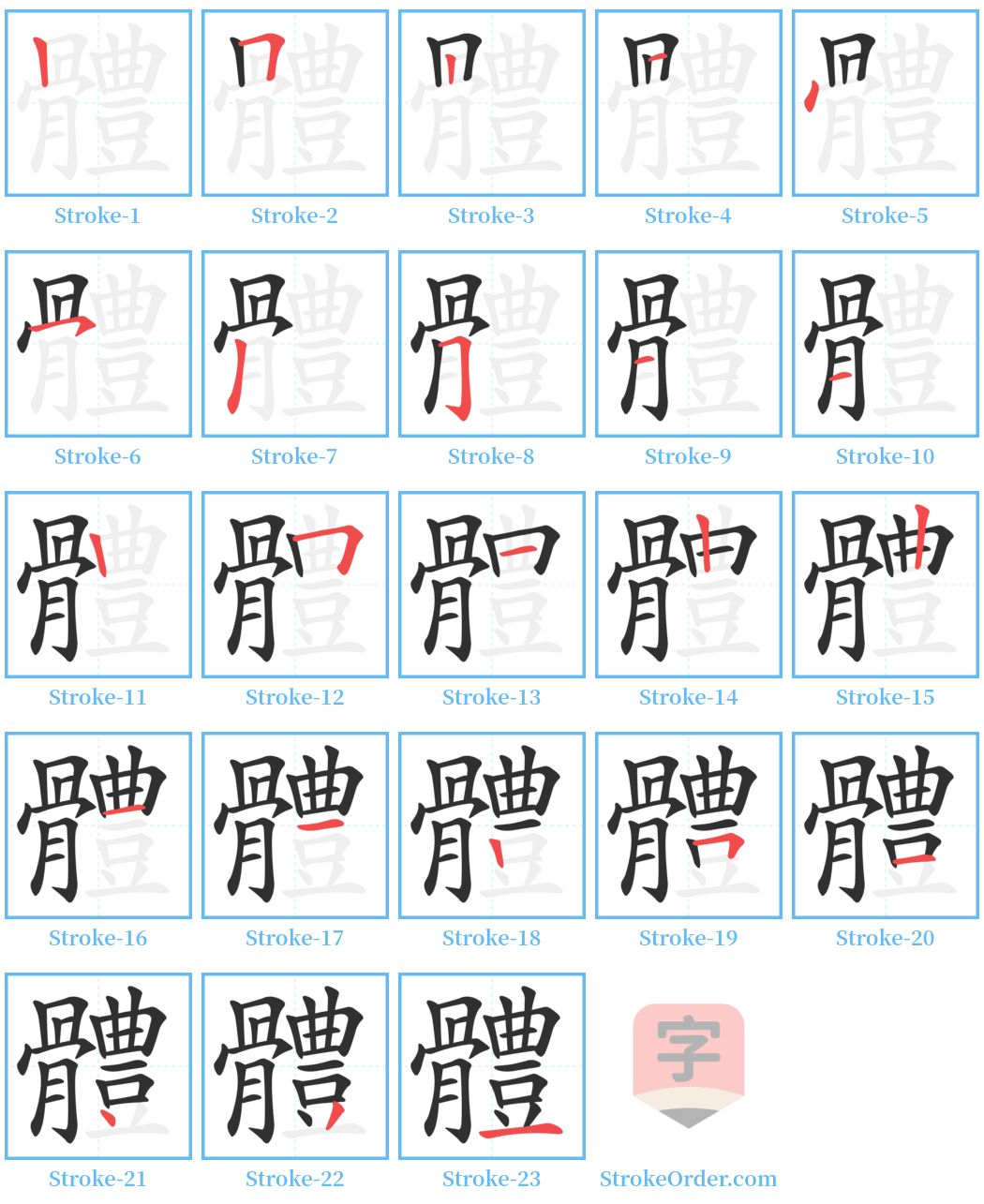體 Stroke Order
Animated Stroke Order of 體

Stroke Order Diagrams for 體

Step-by-Step Handwriting Guide for 體

Learn to Write Chinese Characters with Video Tutorials
Watch the video of writing the Chinese character "體", learn the correct stroke order (笔顺) of the character "體", and master the standard way of writing the character "體".
Free Printable Handwriting Practice with Stroke Order: 體
Printable Writing Practice Worksheet of "體" in Portrait Orientation (Tian Zi Ge)

Printable Writing Practice Worksheet of "體" in Landscape Orientation (Tian Zi Ge)

Information of 體
Pinyin
tǐ、 tī
Radical
骨
Strokes
22 strokes
Usage
★★★
Definition
body / form / style / system
體
tǐ
名詞
【本义】: 身体
1. 人的或动物的全身 (Body of a person or animal)
2. 身体的一部分 (A part of the body)
3. 事物的本身或全部 (The essence or entirety of an object)
4. 物质存在的状态或形状 (The state or shape of material existence)
5. 文章或书法的样式、风格 (The style or genre of writing or calligraphy)
6. 事物的格局、规矩 (The pattern or rules of things)
7. 亲身经验、领悟 (Personal experience or understanding)
8. 设身处地为人着想 (Empathy; putting oneself in others' shoes)
9. 与用相对,指“本体”和“作用”,一般认为“体”是最根本的、内在的;用是“体”的外在表现 (In classical Chinese philosophy, “tǐ” refers to “substance” in contrast to “yòng” or “function”, where “tǐ” is considered fundamental and intrinsic, while “yòng” is its external manifestation.)
例句:
- 身体: 身~。~能。
(Body: A person’s whole physique.)
- 身体的一部分: 四~。
(Part of the body: Four limbs.)
- 事物的本身: 物~。
(The essence of an object: The substance of things.)
- 物质状态: 固~。
(State of matter: Solid form.)
- 文章样式: 文~。
(Writing style: Literary form.)
- 事物的格局: ~系。
(The structure of things: Order and system.)
- 亲身体验: 体知。
(Personal understanding: Knowing through experience.)
- 为他人着想: 体贴。
(Empathetic: Considerate of others.)
- 哲学概念: 体用。
(Philosophical concept: Substance and function.)
---
體
tǐ
動詞
1. 亲身经验; 体察 (To personally experience or observe)
2. 设身处地为人着想 (To put oneself in another's position)
3. 划分,分解 (To divide or dismember)
4. 成形 (To take shape)
5. 表现; 体现 (To show or manifest)
6. 效法 (To model oneself after)
7. 相承; 继承 (To succeed or inherit)
8. 生长 (To grow)
9. 包含; 容纳 (To contain or accommodate)
10. 通“履”,体验; 实行 (To experience or practice)
例句:
- 亲身经历: 体行。
(Personal experience: To practice personally.)
- 设身处地: 体国。
(Consider the country: To empathize with the nation.)
- 划分: 体解。
(Divide or dissect: To dismantle the body.)
- 成形: 体形。
(Taking shape: To materialize.)
- 体现: 体亮 (show).
(To express: To reveal.)
- 效法: 体德 (improve one’s character).
(To emulate: To follow the good example.)
- 生长: 体长 (growth).
(To develop: To grow.)
- 包含: 体容 (to hold).
(To encompass: To contain.)
- 实行: 体干 (to fulfill.).
(To carry out: To execute in practice.)
---
體
tǐ
1. 〔~己〕家庭成员个人的私蓄的财物;亲近的 (Family members' personal possessions; intimate.)